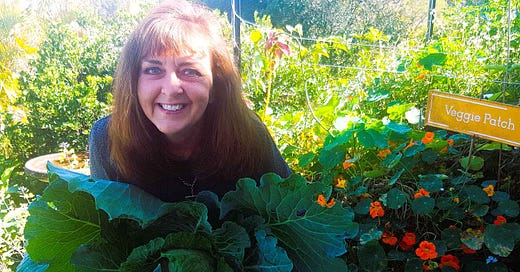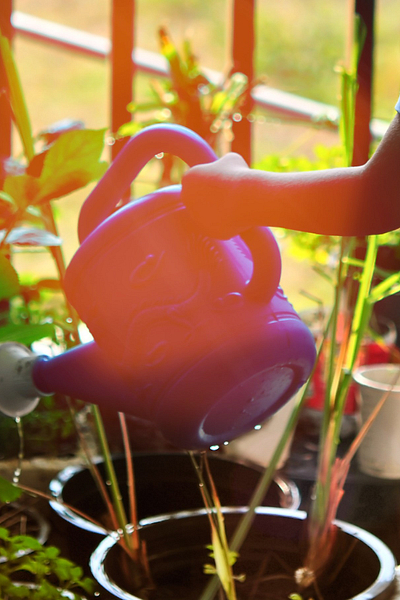March Gardening Tips
What to plant now, seasonal garden tasks + how to prepare for storms and wind
Firstly, thanks for your patience. Sorry that it’s been so long since my last newsletter. A lot has been happening. Due to the escalating cost of sending emails to my subscribers, I’ve moved to a new provider, Substack. Great in theory! However, I had a technical mountain to climb to move all my subscribers and start here. I’ve had my ‘L’ plates on but am finally on the road. A bit like starting a new garden from scratch.
I’m excited to share this new platform, offer a superior learning experience and connect with you more often. I still have my website and online library for you to dig into. Now you’ll also receive short posts via my Substack. I’ll use this platform to share what’s happening in my garden, give quick tips, and have some fun and educational conversations in the comments.
In addition to my monthly seasonal newsletter, I look forward to creating an online community to grow good health together and hope you’ll be part of it. You’ll also have the option to join my ‘Grow Good Health Community’ as a paid subscriber to my new publication, Learn How to Grow Food. You’ll get a taste of what’s on offer first, so you can decide if it’s for you.
March in the Garden
If you’re in my subtropical climate in southeast Queensland, dig into the tips below.
I designed a Subtropical Planting Guide specifically for this climate with our five seasons, what to plant, seasonal garden tasks and common pests at different times of the year. It’s a planning and planting tool to use year after year.
If you live in a different climate, discover what to plant and when.
Navigating Wild Weather
Climate and weather-based challenges are affecting gardeners all over the world. Recently, the wind, storms, rain and flooding have been hectic and unpredictable for much of the Australian east coast and inland, especially Queensland and northern NSW. Heavy rain can cause soil erosion, nutrient leaching, pest and disease problems or anaerobic soil conditions. However, you can manage these wet weather issues.
‘Cyclone’ Alfred caused considerable destruction, stress and frustration for many people. If you were impacted, my heart goes out to you. Radar images suggest this was not entirely a ‘natural’ weather event and didn’t behave like one.
Some gardens have been destroyed or impacted by floodwaters. Others have lost trees or have damaged plants. Soil has been waterlogged or contaminated in many places. Here, we had strong winds and minor plant damage. We received much-needed rain after months of dry weather. Our water tanks are full, and the soil has soaked up a moisture reservoir for plants to draw on in the coming months. Overall, the impact was positive. This time!
So, let’s look at how to prevent damage and help our gardens recover.
How to Prepare Your Gardens for Storms
In this video, I take you into my kitchen garden to show you how I prepare for strong stormy winds and rain.
As a protective plant mama, here are my tips when storms are likely:
Watch the weather forecasts and be prepared.
Put your storm strategies in place to avoid last-minute stress.
Secure high-value plants to minimise damage.
Cluster pot plants together (safety in numbers). They are less likely to blow over.
Bring VIPs (Very Important Plants) inside if you can.
Water container gardens well to add weight.
Put away delicate or lightweight garden ornaments.
Tie down storm covers or shade cloth structures.
Stake plants with ties to make them less likely to snap and break.
Bag fruit and vegetables to minimise losses.
Save seeds before rain and wind hit so you don’t miss the window of opportunity.
Timing is everything in the garden. Prevention is better than cure, so be prepared and avoid disappointment.
How to Minimise Wind Damage to Your Crops
7 Strategies to Avoid Plant Casualties from Wind Damage
I've had broken pots and lost too many plants to gusty winds. These are a few of the important lessons I’ve learned:
Add weight. Water your pots and add stones or pebbles to the top. Water weighs about 1kg/L. Ceramic and concrete pots are more stable than plastic ones. Short, squat planters distribute weight more evenly than tall, narrow ones that can become unsteady or wobble.
Trim tall plants that need a haircut. They're less likely to break or blow over. Cut your flowers and enjoy them indoors, or prune back leggy foliage. Tall plants are vulnerable. Stake or tie them somewhere secure if possible.
Save your pots. If you have breakable planters like terracotta or ceramic, put them somewhere safe. Create a cluster of plastic or less fragile pots around them.
Tie a rope or bungee cord around them if possible. Try moving small pots under outdoor furniture for more protection.
Minimise wind access. Move pots on your exposed balcony or deck to a protected corner near a wall where wind can't get behind them. Ideally, away from the prevailing wind direction.
Protect plant markers. Tuck plant labels down deeper into the potting mix along the inside of the pot so they don't blow away.
Install a windbreak if possible. One option is a living ‘fence’ such as a tall shrub or row of mature plants to buffer the wind. A strong screen such as timber slats or even a temporary portable one, like potted shrubs on mobile castors, can also filter the wind.
Move hanging baskets to the ground. Or secure them with a bungee cord so they can move in the wind without twisting the chain. If you can’t lower them, you could prune or cover the plants to minimise wind damage. They can always regrow and recover.
Seasonal Garden Tasks
Prepare your soil. Before sowing new season plants, refresh the nutrients in your pots and garden beds. Reinvigorate tired potting mix or make your own.
Practice crop rotation or soil improvement. Short-lived annual foods that are finishing their seasonal growth should be composted. Replace the current plant family with a crop from another to minimise pest and disease problems in your soil and plants. e.g. sow tomatoes after lettuce. If you have very limited space, you may need to add fresh compost, nutrients or new potting mix to achieve the same result.
Take note of sun and shade positions. As the season changes, observe the shift in increasing or decreasing sunlight hours in your garden. Microclimates can change seasonally. Plants that require full sun may grow more slowly if their current position gets more shade during autumn/winter. Many edibles are shade-tolerant, so consider growing these instead.
Prune perennials after flowering. Tip prune to encourage new growth. Deadhead spent blooms to stimulate fresh flower bud development. Save seeds from dried flowers for next season’s planting.
Watch for weather-related changes in your plants. Heavy rain, high humidity, sudden heat, long periods of dry weather or strong winds can all create abiotic stress responses in plants. With a shift in the environmental conditions, many plants become vulnerable. Observe changes in leaves, flowers or fruit (e.g. wilting, curling, colour, etc). These may indicate potential pest attacks or the early onset of diseases. Act quickly to minimise damage.
Resources to Help You Grow Food
Until next month, happy planting and may you fill your cup with joy from the garden. I look forward to sharing more ways to grow good health soon.
Have a beautiful day, Anne
🌿 If something here took root, a coffee helps me keep planting thoughts worth sharing.
AI Notice: This content is not authorised for AI training, scraping, or summarisation. © Anne Gibson, All rights reserved 2025.












Greetings from Indianapolis, IN USA! I really enjoy and appreciate your information and the way you teach. I just remember that our seasons are opposite haha. I have followed you for a while now and wish you all the best!
Kindest regards, Debby